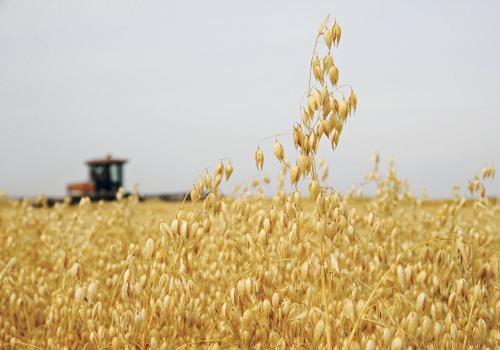Canadian grain farmers grew a huge oat crop in 2020. It came at a time when global demand for oats was high due to a number of factors, including increased demand from the United States and Mexico, and lower production in Australia, a key competitor. Another major factor was unexpectedly strong demand from South America, primarily Chile, said market analyst Chuck Penner with LeftField Market Research. Chile typically supplies oats to neighbouring South American countries but Chilean supplies were insufficient this year and Canadian oat exporters stepped in to fill the shortfall. Chilean demand boosted Canadian exports in 2020 but it remains to be seen if Chile or other South American countries will continue to buy Canadian oats in 2021, Penner said during an oat market outlook at Crop Production Week.
What’s more, with higher demand for oats and strong prices, Australian oat producers may be lured back into the market and could chip away at Canadian sales into some countries, including Mexico. “We (Canada) had an oat crop of a little over 4.5 million tones in 2020 and that was the biggest crop we’ve had in well over a decade,” Penner said. From an export perspective “that was starting to look fairly heavy at the beginning of the year, based on normalish utilization and demand… but very quickly prices started to move higher in spite of the bigger crop.” “Who knew that South America would suddenly arrive as a huge oat buyer?” So far in the 2020-21 crop year, demand for Canadian oats has been on a roll. Through the first five months, Canada has exported record volumes of oats — more than a million tonnes as of Week 22. That does not include Canadian oats that were transported south into the United States. Much of Canada’s exports have gone to Chile, which is typically an exporter itself, and to Mexico, which until recently had been supplied largely by Australian oats. Canadian exports of oat flakes and processed oat products has also been strong, lending to good selling opportunities for Canadian producers, Penner said. Strong international demand provided support for Canadian oat prices in late 2020 and the outlook for Canadian oats remains strong heading into 2021. But there are a few caveats.
First, with global oat markets showing unusual strength, Canada’s oat-producing competitors are beginning to take notice. Australian oat production, which has been lower than average for the last couple years, is rebounding. The latest Aussie oat harvest jumped to 1.6 million tonnes and with Canadian oats commanding strong prices in the Unites States and South America, Australian exporters may be in a position to recapture some market share, particularly in Mexico. Scandinavian oats, which can also displace Canadian oats into the U.S., could also gain traction. “If Canadian oat prices keep rallying the way they are, that could make European oats a little bit more competitive again into that (U.S.) market,” Penner said. “It won’t be a huge amount but it could be enough to take the edge of that market.” Another key question is how much new crop oats will Canada harvest in the fall of 2021. Based on a pre-Christmas analysis, Penner had oats as the highest margin cereal grain entering 2021, at least for producers in Saskatchewan’s black soil zone. But markets for many Canadian crops are changing quickly and seeding decisions have yet to be finalized, he added.
Penner said competition for Canadian acres will be high this spring with markets for most Canadian crops currently pointing at continued strength. Spot prices for Canadian oats typically fall between February and April before rebounding in May and peaking in July and August. This year, however, it seems more likely than usual that Canadian oat exports will keep on chugging along. Prices could remain strong throughout the spring season. “I don’t think we’re going to see much slippage going into the spring,” Penner said. So what does that mean for Canadian production and supplies in the 2021-22 crop year? Penner suggested relatively steady plantings this spring, unchanged from 2020 at around 375,000 acres. New crop supplies are projected to be on the high side at around five million tonnes, including roughly 550,000 tonnes of carryout from 2020-21. A 550,000 tonne carryout would be larger than the last two years, but it would not be considered huge.
In 2013-14, for example, carryout stocks were nearly twice that high, approaching 1.1 million tonnes. Penner conceded, however, that with total supplies (new crop and carry-out) expected in the five million tonne range this fall, Canadian exporters and producers will have their fingers crossed for continued strong demand. “When I’m looking forward to next year, I’m still expecting a little bit stronger demand from the U.S., but some of that new demand from South America and Mexico may fade,” Penner said. “I don’t know if we’ll see exports again as strong as they are in this current year. If there’s a bit of a cloud on the horizon (for Canadian oat producers), that might be it.” Limited soil moisture reserves across much of Western Canada’s oat-growing region could also affect seeding decisions and new crop supplies, he said. Marlene Boersch, a markets analyst with Mercantile Consulting Venture Inc., said it’s hard to predict how new crop oat prices will respond until more is known about Canadian acreage. That said, new crop bids in the $3.50 to $4 per bushel range are not impossible. “We have to get a bit better reading in the acreage this spring before you can really reasonably answer that,” Boersch said. If you see year-over-year acreage increases of two percent in wheat and canola, for example, significant increases in oat acreage are much less likely, she said. “Once you start tinkering in the major commodities, you don’t have much room to move with the smaller commodities,” she said.
